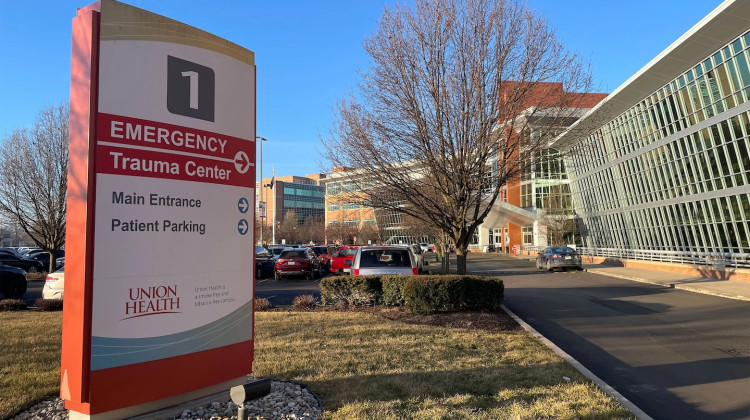
James Kidwell, 57, waits to receive a procedure that could beat back an invasion of harmful bacteria called Clostridium difficile, or C-diff, in his colon.
Jake HarperThree weeks ago, James Kidwell, 57, lay in a bed at IU Health University Hospital., waiting to receive a procedure he hoped would beat back an invasion of harmful bacteria called Clostridium difficile, or C-diff, in his colon.
"It causes really bad diarrhea and it’s really painful when you have to go the restroom and such, and it causes a lot of pain on the insides," says Kidwell. "With me it generated down my legs and it made it hard to walk and stand on my legs."
And it’s more than just uncomfortable. According to a recent report from the CDC, an estimated 29,000 people are dying each year from C-diff because the infections are often resistant to antibiotics and hard to treat. Kidwell has had five flare-ups in the last few months. His doctors put him on antibiotics each time, and even though they helped temporarily, the C-diff kept coming back. The infection forced him to go to the bathroom 30 to 40 times a day, and made it hard for him to do even basic tasks.
So Kidwell drove to Indianapolis from his home in Kokomo to meet with gastroenterologist, Dr. Monika Fischer, an expert in fecal microbiota transplant, a procedure to infuse a healthy person’s feces into the colon of a C-diff patient. It’s a technique that’s been shown to be highly effective, but is still not commonly available.
Fischer wants to change that. She recently conducted a study of fecal transplant for the most severe cases of C-diff. Left unchecked, a C-diff infection can lead to severe inflammation and even organ failure. Cases like this are often thought of as too far gone for fecal transplant. So the current standard treatment for a severe C-diff infection is colectomy, a surgery to remove part or all of someone’s infected colon. But even if the patient is well enough to undergo that surgery, the 30-day survival rate is only around 50 percent.
Hoping to cure them without need for risky surgery, she gave 29 patients with severe C-diff infections a fecal transplant, or sometimes more than one, and 27 of them pulled through.
"We devised a protocol that is working beautifully, and helps people avoid colectomy and walk out of the hospital," she says.
Fischer says that ideally, patients would get the transplant sooner, so that the disease doesn’t progress too far. Kidwell is a good example of this. Though his infections are antibiotic resistant, he’s technically not yet a “severe” case. And he doesn’t want to be.
In the hospital operating room, Kidwell lay anesthetized while Fischer inserted a colonoscope and worked her way to the end of Kidwell's colon. Sitting behind her, connected to a pump, was a plastic bottle full of brown goo—the donor stool. Once Fischer reached the end of Kidwell's bowel, the pump was switched on and the bottle steadily emptied. It had been filtered and liquefied, but the poo was still full of helpful bacteria, the kind Kidwell needs to crowd out the harmful C-diff.
"So by the time the patient wakes up, the stool hopefully covers the entire colon and allows these bacteria to repopulate the intestine," says Fischer.
As strange as it may seem, putting someone else’s feces into a patient suffering with C-diff is an extremely effective way to treat the infection. A healthy person’s colon is full of billions of bacteria which live in a symbiotic relationship with the human body. C-diff infection puts that ecosystem severely out of balance, but a fecal transplant can restore the population of friendly bacteria. Depending on how the procedure is performed, the success rate can be higher than 90 percent.
For now, the procedure isn’t available everywhere, and it could take some convincing to get doctors to try fecal transplants, especially for extremely sick patients. It might just seem too dangerous, but Fischer says it’s not.
"We are offering a procedure that has minimal risk, so it is very safe, even in this critically ill population," she says. "Why not try, even if it's not going to work?"
If the idea catches on in hospitals across the U.S., Fischer says many lives could be saved.
As for James Kidwell, he’s out of the hospital now, and shopping for RV’s. Quite a change for a guy who not long ago was afraid to go too far from a bathroom.
Contact reporter Jake Harper at jharper@wfyi.org or follow him on Twitter @jkhrpr.
 DONATE
DONATE








 View More Articles
View More Articles


 Support WFYI. We can't do it without you.
Support WFYI. We can't do it without you.